Sushi is a traditional Japanese dish that has become increasingly popular worldwide. It is made with vinegared rice and various ingredients, including raw fish, known as sashimi. Sushi-grade salmon is a term used to describe the highest quality salmon that is suitable for raw consumption. It is essential to understand what sushi grade salmon means and where to buy it to ensure that you are getting the best quality fish for your sushi.
Sushi grade salmon is not a regulated term, and there are no official standards for it. However, it generally refers to salmon that has been caught, handled, and processed in a way that minimizes the risk of parasites and bacteria. The fish must also be fresh and of high quality to be considered sushi-grade. When purchasing sushi-grade salmon, it is crucial to buy it from a reputable source that you trust.
Key Takeaways
- Sushi grade salmon is a term used to describe the highest quality salmon suitable for raw consumption.
- Sushi grade salmon must be fresh, of high quality, and handled and processed in a way that minimizes the risk of parasites and bacteria.
- When purchasing sushi grade salmon, it is crucial to buy it from a reputable source that you trust.
Understanding Sushi Grade Salmon

When it comes to sushi, the quality of the fish is paramount. Sushi grade salmon is a term used to describe salmon that is of high enough quality to be eaten raw in sushi or sashimi. But what exactly does that mean?
According to the FDA, there are no specific regulations or guidelines for what constitutes “sushi grade” fish. However, the term generally refers to fish that has been carefully handled and stored to minimize the risk of contamination and parasites.
To ensure the safety of raw consumption, many suppliers follow the FDA guidelines for freezing fish. Freezing fish at -4°F for seven days or -31°F for 15 hours will kill any parasites that may be present. Some suppliers may also use a process called “super-freezing,” which freezes the fish at even lower temperatures to ensure that all parasites are killed.
When it comes to salmon, there are a few things to look for when buying sushi grade fish. Wild-caught salmon is generally preferred over farm-raised salmon due to its higher quality and lower risk of contamination. Additionally, the color of the salmon can be an indicator of its quality. Bright, vibrant orange-pink flesh is a sign of a healthy, well-fed fish.
It’s also important to note that not all salmon are suitable for raw consumption. While most salmon can be eaten raw if it has been frozen properly, not all salmon is considered “sashimi-grade.” Sashimi-grade salmon is the highest-quality salmon available and is specifically selected for its texture, flavor, and appearance.
When looking for where to buy sushi grade salmon, it’s important to find a reputable supplier who follows proper handling and storage practices. Local seafood retailers and online seafood delivery services can be good options, as long as they have a track record of providing high-quality, safe fish.
Overall, understanding what sushi grade salmon is and what to look for when buying it can help ensure that your sushi or sashimi is both delicious and safe to eat raw.
Where to Buy Sushi Grade Salmon

When it comes to making sushi, the quality of the salmon is crucial. Sushi grade salmon refers to salmon that has been handled and prepared in a way that makes it safe to eat raw. Here are some places where you can buy sushi grade salmon:
Fish Markets and Fishmongers
Fish markets and fishmongers are excellent options for buying sushi grade salmon. They typically have a wide selection of fresh fish, including salmon, and can provide you with expert advice on how to select the best fish for your needs. They can also prepare the fish for you, removing the skin and bones, which can save you time and effort.
Online Retailers
Buying sushi grade salmon online is another option. There are many online retailers that specialize in selling high-quality fish, including salmon, that is safe to eat raw. Some popular online retailers include Catalina Offshore Products and Fish for Sushi.
Supermarkets and Grocery Stores
Although it may be more challenging to find sushi grade salmon at your local supermarket or grocery store, it is still possible. Look for stores that have a good selection of fresh fish, and be sure to ask the fishmonger if the salmon is safe to eat raw. If you are unsure, it is always better to err on the side of caution and cook the salmon before eating it.
Specialty Stores
Specialty stores that focus on Japanese cuisine or sushi-making supplies may also carry sushi grade salmon. These stores may have a wider selection of fish, including rare or hard-to-find varieties.
When buying sushi grade salmon, it is essential to purchase it from a reputable source. Look for stores or retailers that have a good reputation for selling high-quality fish. Always ask the fishmonger or retailer if the salmon is safe to eat raw, and be sure to follow proper food safety guidelines when preparing and storing the fish.
Online Shopping for Sushi Grade Salmon

If you’re looking to buy sushi grade salmon online, there are several options to consider. Online shopping for sushi grade salmon offers convenience, a wider selection, and the ability to compare prices and offers.
One important factor to consider when shopping for sushi grade salmon online is the freshness of the fish. Look for online retailers that offer overnight delivery to ensure that the fish arrives fresh and ready to use. Some retailers also offer same-day delivery in certain areas.
When shopping for sushi grade salmon online, it’s important to look for retailers that specialize in fresh seafood. These retailers are more likely to offer high-quality fish that is suitable for sushi. Some retailers may also offer whole fish, which can be a cost-effective option for those who are comfortable with filleting the fish themselves.
Prices for sushi grade salmon can vary depending on the retailer and the type of salmon. Look for online retailers that offer competitive prices and consider signing up for their email newsletters to stay up-to-date on any special offers or discounts.
Availability is another important factor to consider when shopping for sushi grade salmon online. Look for retailers that have a wide selection of salmon types and cuts, as well as those that offer seasonal specialties.
In summary, online shopping for sushi grade salmon offers convenience, a wider selection, and the ability to compare prices and offers. When shopping online, look for retailers that specialize in fresh seafood, offer overnight delivery, and have a wide selection of salmon types and cuts. Keep an eye out for special offers and discounts to get the best value for your money.
Types of Sushi Grade Fish
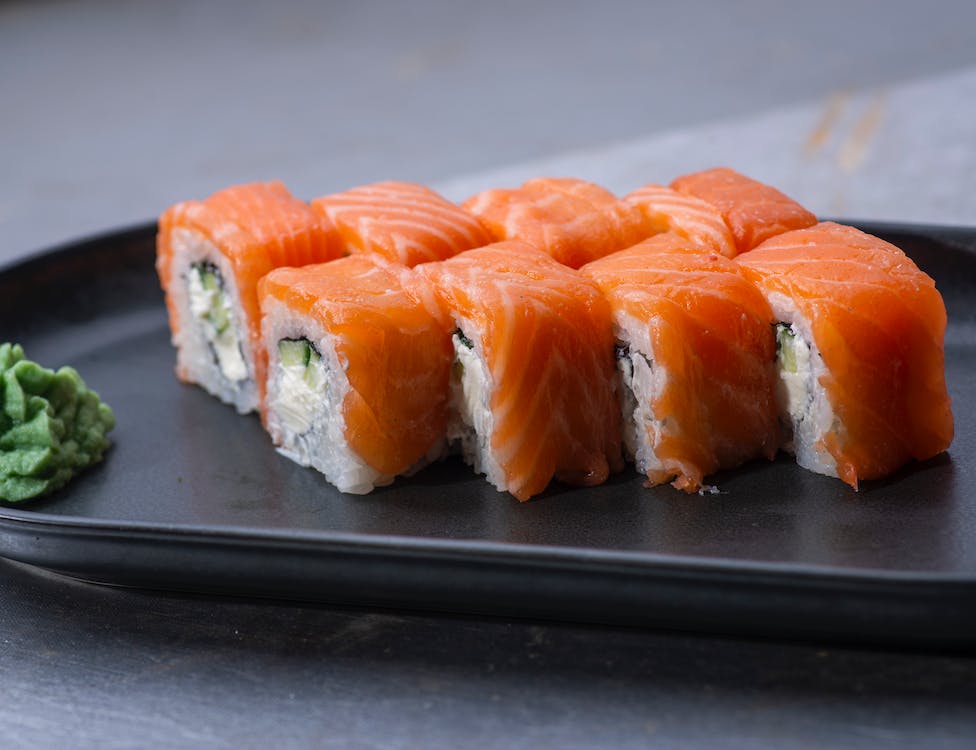
When it comes to sushi grade fish, not all types of fish are created equal. Here are some of the most popular types of sushi grade fish:
Tuna
Tuna is one of the most popular types of sushi grade fish. There are several types of tuna that are commonly used in sushi, including bluefin, yellowfin, and albacore. Bluefin tuna is the most prized and expensive type of tuna, while yellowfin and albacore are more affordable.
Salmon
Salmon is another popular type of sushi grade fish. When it comes to salmon, it’s important to note that farmed salmon is generally considered safer for raw consumption than wild salmon. If you’re purchasing salmon for raw consumption, it’s best to go with farmed salmon.
Shrimp
Shrimp is a common ingredient in sushi rolls, and it’s important to use high-quality shrimp that is safe for raw consumption. Look for shrimp that is labeled as sushi grade or sashimi-grade.
Flounder
Flounder is a mild and delicate fish that is commonly used in sushi. It’s important to choose high-quality flounder that is safe for raw consumption.
Mackerel
Mackerel is a rich and flavorful fish that is commonly used in sushi. It’s important to choose high-quality mackerel that is safe for raw consumption.
Ahi Tuna
Ahi tuna, also known as yellowfin tuna, is a popular type of sushi grade fish. It has a meaty texture and a rich flavor that pairs well with soy sauce and wasabi.
Sole
Sole is a mild and delicate fish that is commonly used in sushi. It is often served with a light seasoning to enhance its natural flavor.
Other Types of Sushi Grade Fish
In addition to the types of sushi grade fish listed above, there are many other types of fish that can be used in sushi, including skipjack, bonito, and bigeye tuna. When choosing fish for sushi, it’s important to choose high-quality fish that is safe for raw consumption.
Frozen vs Fresh Sushi Grade Salmon
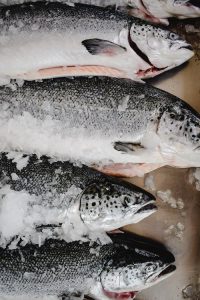
When it comes to buying sushi grade salmon, you might wonder whether frozen or fresh is the better option. The truth is, both options have their pros and cons.
Frozen Sushi Grade Salmon
Frozen sushi grade salmon is typically flash-frozen immediately after being caught to preserve its quality and freshness. This process helps to kill any potential parasites or bacteria that may be present in the fish. Once thawed, frozen salmon can be just as fresh and delicious as fresh salmon.
One advantage of buying frozen sushi grade salmon is that it is often more readily available than fresh salmon. You can order it online and have it delivered straight to your door, which is especially convenient if you don’t live near a fish market or specialty store.
Another advantage of frozen salmon is that it can be less expensive than fresh salmon. This is because frozen salmon can be stored for longer periods of time, which means that suppliers can offer it at a lower price.
Fresh Sushi Grade Salmon
Fresh sushi grade salmon is salmon that has never been frozen. It is typically caught and then immediately transported to markets and restaurants. Because it has never been frozen, fresh salmon has a slightly different texture and flavor than frozen salmon.
One advantage of buying fresh sushi grade salmon is that you can see and smell the fish before you buy it. This can help you ensure that you are getting the highest quality fish possible.
However, one downside of fresh salmon is that it can be more expensive than frozen salmon. This is because fresh salmon has a shorter shelf life and must be sold quickly before it goes bad.
In conclusion, whether you choose frozen or fresh sushi grade salmon depends on your personal preferences and needs. If you want convenience and affordability, frozen salmon may be the way to go. If you value freshness and are willing to pay a premium, fresh salmon may be the better option.
Selecting the Best Sushi Grade Salmon
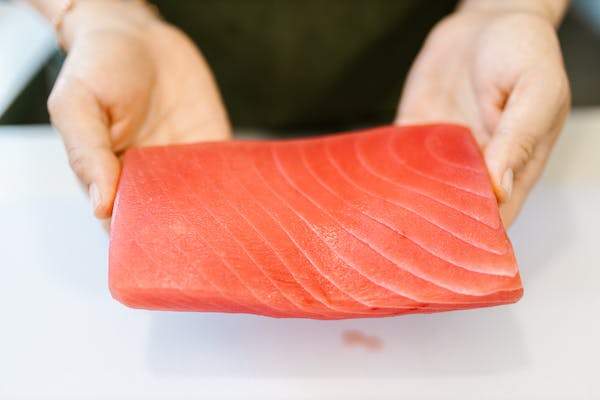
When it comes to selecting the best sushi grade salmon, there are a few factors to keep in mind to ensure that you are getting the freshest and highest quality fish possible.
Firstly, it is important to choose a reputable supplier that specializes in sushi grade fish. Local fish markets, Japanese grocery stores, and online retailers are all good options. Look for a supplier that sources their fish directly from reputable and sustainable fisheries.
When selecting the salmon, pay attention to its appearance and smell. The fish should have a shiny and firm texture, with no signs of discoloration or bruising. It should also have a fresh and oceanic aroma, with no off-putting smells.
Next, give the fish a gentle press with your fingers. It should feel firm and springy, with no mushy or soft spots. The eyes should also be clear and bright, not cloudy or sunken.
Finally, check the labels to ensure that the fish is indeed sushi grade and safe to eat raw. The label should indicate that the fish has been previously frozen to kill any potential parasites. It is recommended to only purchase fish that has been previously frozen for at least 24 hours at -4°F (-20°C) or below.
By following these guidelines, you can confidently select the best sushi grade salmon for your next raw fish dish.
Preparing Sushi Grade Salmon

When it comes to preparing sushi grade salmon, it is essential to choose a high-quality fish that is safe to eat raw. Here are some tips to ensure you get the best results:
Buying Raw Salmon
When buying raw salmon, it is important to look for fish that is labeled as sushi grade. Sushi grade salmon is the highest quality fish that is safe to eat raw. It has been handled with utmost care, caught, and stored safely.
Preparing Sushi
Sushi is a popular Japanese dish that consists of vinegared rice and a variety of fillings, including raw fish. To prepare sushi, you will need the following ingredients:
- Sushi rice
- Sushi vinegar
- Sushi grade salmon
- Nori sheets
- Wasabi
- Soy sauce
To prepare sushi grade salmon for sushi, you will need to slice it into thin strips. Use a sharp knife to slice the fish against the grain, making sure to remove any bones.
Preparing Nigiri
Nigiri is a type of sushi that consists of a small ball of rice topped with a slice of raw fish. To prepare nigiri, you will need the following ingredients:
- Sushi rice
- Sushi vinegar
- Sushi grade salmon
- Wasabi
- Soy sauce
To prepare sushi grade salmon for nigiri, you will need to slice it into thin strips. Use a sharp knife to slice the fish against the grain, making sure to remove any bones. Then, shape the rice into small balls and top each one with a slice of salmon.
Preparing Poke
Poke is a Hawaiian dish that consists of diced raw fish, usually served over rice or greens. To prepare poke, you will need the following ingredients:
- Sushi grade salmon
- Soy sauce
- Sesame oil
- Rice vinegar
- Green onions
- Avocado
- Cucumber
- Edamame
- Sesame seeds
To prepare sushi grade salmon for poke, you will need to dice it into small cubes. Mix the salmon with soy sauce, sesame oil, and rice vinegar. Then, add in diced green onions, avocado, cucumber, and edamame. Top with sesame seeds.
In conclusion, preparing sushi grade salmon requires choosing high-quality fish that is safe to eat raw. Whether you are making sushi, nigiri, or poke, it is important to use fresh ingredients and follow proper food safety guidelines.
Storing Sushi Grade Salmon
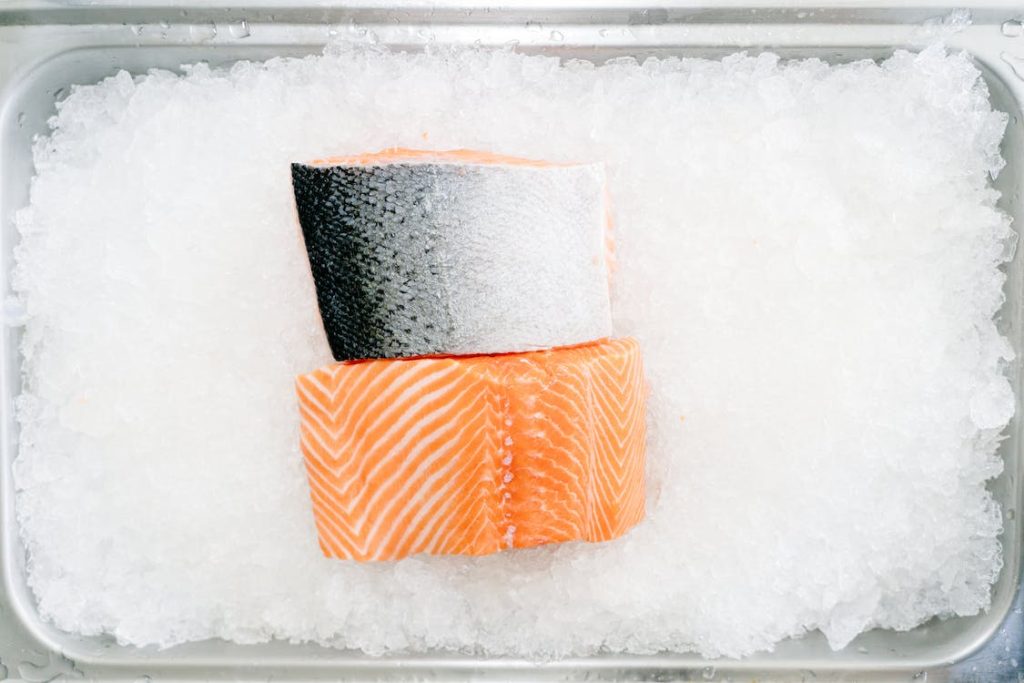
When it comes to storing sushi grade salmon, it is essential to maintain its freshness to ensure safety and quality. Here are some tips on how to store sushi grade salmon properly:
Refrigeration
The best way to store sushi grade salmon is in a refrigerator. Keep it in the coldest part of the fridge, which is usually at the back. The temperature should be set to 32°F to 38°F (0°C to 3.3°C) to prevent bacterial growth. Always wrap the salmon tightly in plastic wrap to prevent air from getting in and causing freezer burn.
Ice
If you need to store sushi grade salmon for an extended period, consider packing it in ice. Place the wrapped salmon in a plastic bag and then put it in a bowl of ice. Make sure to change the ice every few hours to keep the temperature low.
Time
It is best to consume sushi grade salmon as soon as possible after purchasing it. However, if you need to store it, make sure to consume it within two days. After two days, the quality of the fish will start to deteriorate, and it will no longer be safe to consume.
Temperature
Sushi grade salmon should always be kept at a cool temperature. If you are transporting the salmon, make sure to keep it in a cooler with ice packs to prevent it from warming up. Also, avoid leaving the salmon out at room temperature for an extended period.
In conclusion, storing sushi grade salmon is essential to maintain its freshness and quality. Always keep it in the refrigerator, pack it in ice if necessary, consume it within two days, and keep it at a cool temperature. By following these tips, you can enjoy delicious and safe sushi grade salmon.
Safety Concerns with Sushi Grade Salmon
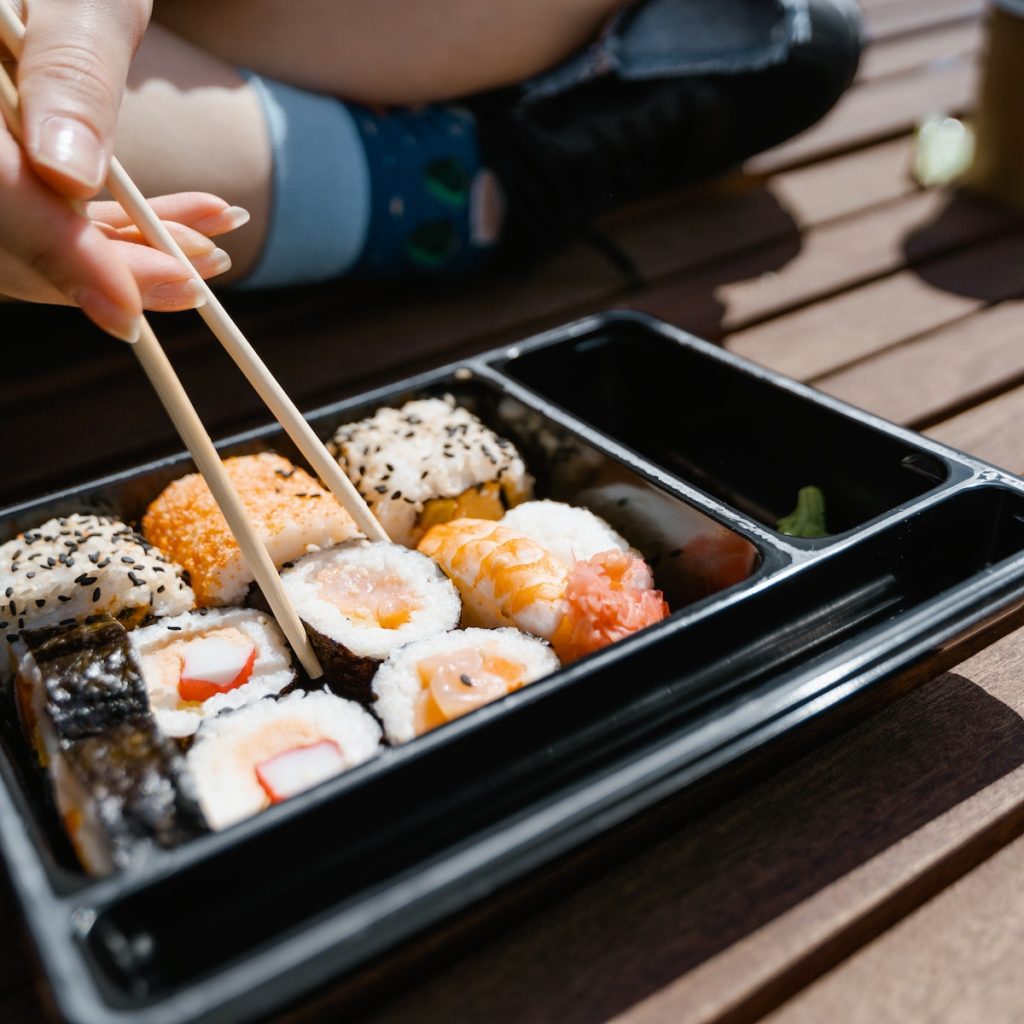
Sushi grade salmon is a type of salmon that is safe to eat raw. However, there are still some safety concerns that you should be aware of before consuming it. Here are some of the main safety concerns to keep in mind:
Parasites
One of the biggest safety concerns with raw fish, including sushi grade salmon, is the risk of parasites. Parasites are organisms that live on or inside another organism and can cause harm. Some of the most common parasites found in fish include Anisakis, which can cause an infection called anisakiasis, and Diphyllobothrium, which can cause a type of tapeworm infection.
To reduce the risk of parasites, sushi grade salmon must be frozen before being consumed. The FDA recommends that fish be frozen at a temperature of -4°F or below for at least 7 days to kill parasites. This process is known as “freezing and storing” and is required by law in the United States for fish that will be served raw or undercooked.
Bacteria
Another safety concern with raw fish is the risk of bacterial contamination. Bacteria such as Vibrio, Salmonella, and Listeria can cause serious illness if consumed. To reduce the risk of bacterial contamination, it is important to handle and store sushi grade salmon properly. This includes keeping it refrigerated at a temperature of 40°F or below, and using it within 24 hours of purchase or thawing.
FDA Guidelines
The FDA provides guidelines for the safe handling and preparation of fish, including sushi grade salmon. These guidelines include recommendations for storing and handling fish, as well as for cooking and serving it safely. It is important to follow these guidelines to reduce the risk of foodborne illness.

Konnichiwa! (Hello!) I'm Pat Tokuyama, a Japanese tofu cookbook author, who travels for music, food, and adventure. If you like Japanese tea, checkout some of the newestorganic japanese tea, matcha bowls and noren and more!
** Curious about the Plant Based Japanese Cooking Club? ** Learn more here!
Infection
Consuming raw fish, including sushi grade salmon, can also increase the risk of infection. This is especially true for people with weakened immune systems, such as pregnant women, young children, and the elderly. To reduce the risk of infection, it is important to only consume sushi grade salmon that has been properly handled and stored. Also, if you are at high risk for infection, it’s best to avoid consuming it.
In summary, while sushi grade salmon is safe to eat raw, there are still some safety concerns that you should be aware of. By following proper handling and storage guidelines, and by only consuming sushi grade salmon that has been properly frozen and stored, you can reduce the risk of foodborne illness and enjoy this delicious fish safely.
 Alas Sushi Making Kit
Alas Sushi Making Kit This kit doesn't just provide you with a rolling mat; it's your ticket to crafting perfect sushi rolls like a pro. Whether you're a sushi novice or a seasoned chef, this kit, complete with a rolling mat, will help you create sushi that's as visually stunning as it is delicious.






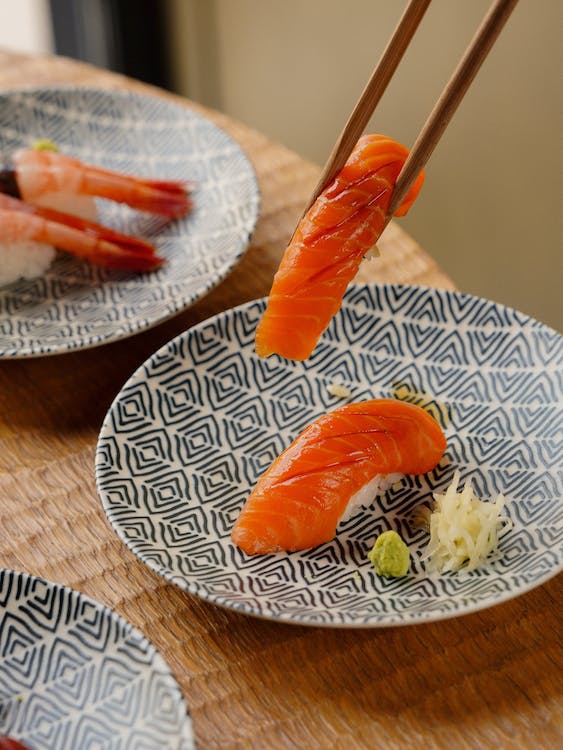

Konnichiwa! (Hello!) I'm Pat Tokuyama, a Japanese tofu cookbook author, who travels for music, food, and adventure. If you like Japanese tea, checkout some of the newestorganic japanese tea, matcha bowls and noren and more!
** Curious about the Plant Based Japanese Cooking Club? ** Learn more here!